
|
|
THE GAMBIA
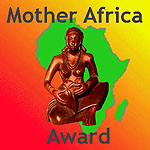
|
|
|
|

|
|
|
Official Name
|
Republic of the Gambia
|
|
Located
|
West: surrounded by Senegal
|
|
Capital
|
Banjul
|
|
Head of State |
President Colonel (RTD) Yahya A.J.J. Jammeh
|
|
Area
|
10,690 sq km
|
|
Population
|
1.2 million
|
|
Growth rate
|
3.6%
|
|
Language
|
English, Mandinka, Wolof & Fula
|
|
Currency
|
Dalasi
|
|
GNP per capita
|
$950
|
|
Inflation
|
5%
|
Airlines
|
from Europe & U.S.A.: Brussels Airlines
from Asia: ________________
from USA: ________________
|
Hotels
(advertise here)
|
Names & Rates per night
______________________
______________________
|
|
USAfrica Agent
|
Afripromo/Conakry
|
|
Country Advertiser
|
If you want to become
the Country Advertiser
your logo comes here.
|
|
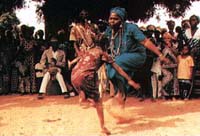
İ2001: Tourist Office
Mandinka Dance
|

İ2002: "De Vegtertjes"
Banjul
|
|
|
Named after The River Gambia which flows through its length from East to West for three hundred miles, The Gambia is a
small country, 500 km long and 25 to 50 km wide. It has been made famous in the rest of the world by Alex Haley, author
of Roots, tracing his ancestors back to the village of Juffure. "Roots" and the tv serialization of this novel directed
the eyes of the world on to the plight of the Africans that were taken into slavery and their struggle for emancipation.
This struggle lasted for over 300 years and at the cost of millions of lives. The Gambia not only offers unspoiled
traditional villages and superb beaches but is also a stable political environment. Mysterious Wassu Stone Circles are
located 25 km northwest of Georgetown near the town of Kuntaur. Banjul is the capital of Gambia. Until 1973, it was
known as Bathhurst. Banjul is a port city on the Atlantic Ocean and lies near the mouth of the Gambia river.
The Gambia River is a "Pearl of Africa".
|

İ2002: Vegtert/USAfrica
|

İ2002: Vegter/USAfrica
|

İ2002: Vegter/USAfrica
|
Culture:
International Roots
Homecoming Festival
: An annual reunion with the African Diaspora. The "Roots" Homecoming Festival commemorates
the forced enslavement and transportation of millions of Africans to the Americas and the Diaspora. The objective of
the Festival is to celebrate the richness and diversity of Gambian culture and the prelude to the establishment of a
Diaspora Heritage Center at Juffure (the ancestral homeland of the famed Kunta Kinteh of "Roots"). It also aims to
bring Africans together to build Africa.
If you like to witness absolute mayhem from behind the safety of a fence, you cant miss the weekend (grease covered)
wrestling matches in Srekunda from 5 to 7 pm, 2 km east of the market. Just ask for the Boreh (the Wolof word for
these proceedings), or for les lutes, the term used for such bouts in Senegal. It is a definite highlight of a trip
to The Gambia, a real chance to mix with the locals and a great chance for photographs.
|
|
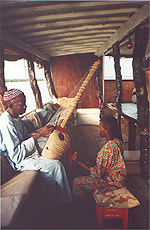
İ2002: Vegter/USAfrica
|

İ2002: Vegter/USAfrica
|
|

İ2002: Vegter/USAfrica
|
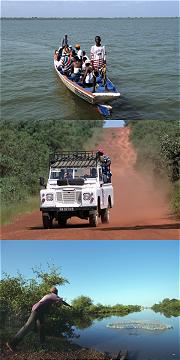
İ2001: Tourist Office
|
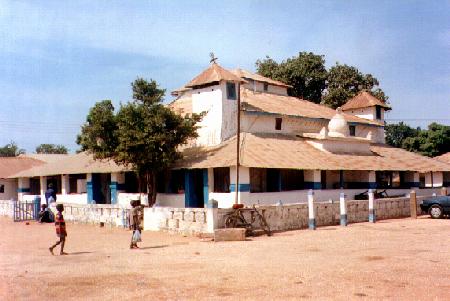
İ2001: Bernard Cloutier
"Sukuta Mosque"
|
|
|
The principal ethnic groups are the Wollofs and the Mandinkas the former living mainly in the capital city of Banjul,
while the latter constitute the single largest tribal unit of The Gambia. These ethnic groups are reminiscent of the
former Empire of the Wollofs in the Senegambian Region and the famous Mandingo Empire of Mali and Songhai. In addition
there are the light-skinned and straight-haired Fulas and the trading Sarahuleys. Another group, the Akus or Creoles,
are an important segment of the local elite; there are some Mauritanians, Morrocans and Lebanese, mostly traders and
shopkeepers. The Gambians are usually tall, dark and sturdy people with fine features and an easy going charm. Each
ethnic group speaks its own language, but English is commonly spoken as well as being the official language of the
country. There not only is harmony between the different groups, but a fusion is taking place by cultural interaction
and intermarriage, to an extent that the Gambia can be called a melting pot of West African ethnic groups where a modern
composite African is being evolved. The population is predominantly Muslim with more than 90% following Islam. The
remaining 10% are mostly Christians of different denominations including Anglicans, Methodists, and Roman Catholics.
Most of the people are strict in their Religious practices and the devout Muslims can be seen praying not only in
Mosques but also in other public places at all prayer times of the day. There is, however, no fanaticism and amity
prevails between religious and ethnic groups.
|
Economy:
The Gambia's economy remains highly vulnerable to adverse external and domestic shocks, in the absence of significant
investment to help it diversify its narrow economic base (manufacturing for exports, tourism and other services) and
expand export-oriented activities. Tourism flourishes because of European tourists - success as much as the south of
Portugal, the Algarve. Although mostly set up hotels by Westerners; Gambians are also thriving on this success and
learning to create their own tourism business.

İ2002: Vegter/USAfrica
Airport
|

İ2002: Vegter/USAfrica
Monkey Bread
|

İ2002: Vegter/USAfrica
N'Dama Cow
|

İ2002: Vegtert/USAfrica
Lambert at the beach
|
History:
Gambia came under British influence during the colonial times. Banjul was instituted by the British in 1816 as a
military post. The city of Bathhurst, as it was called, came from the British colonial secretary at the time. This
city became the British colony capital. When Gambia became independent in 1965, the town became a city, as well as
the national capital. The country's long tradition of democratic institutions was interrupted by an unsuccessful
coup d'etat in 1981, and a military take-over in July 1994. By early 1997, The Gambia returned to constitutional rule.
Limited natural resources and an underdeveloped human capital base have been constraints for both the diversification
of the economy and its growth.
The Bank of The River Gambia have been inhabited for many centuries. Hanno, The Carthaginean, referred to Gambia while
writing about his voyage to West Africa in 470 B.C. It is known that between the 5th and 8th centuries most of the
Senegambian Area came from the Sarahuley ethnic group, and those descendants can be found in The Gambia. The Ghana
Empire which had its capital in present day Mauritania, soon gave way to the Songhais, who latter became Muslims and
promoted their new faith zealously. Around the 13th century, however, Mandingoes and Susus' from the Futa Jallon
Plateau had established themselves in what is now Mali, and from there controlled the whole of The Gambia Basin.
The Gambia was then inhabited mainly by wollofs on the Northern bank and Jolas on the southern bank of the River.
When the Mali Empire declined at the end of the 16th century, the Mandingo leaders retired to the Futa Jallon,
but continued to have influence over the Casamance (Southern Senegal) and The Gambia until early in the 18th century.
Later The Fula invaders penetrated the region. The Ancestors of the Fulas had come from Africa and earlier had
founded the famous Emirates of' Northern Nigeria. During the 18th and 19th centuries, there were protracted wars
between the Islamic Marabouts and the Pagan Soninkis. The British, who already established themselves at Banjul by
this time, offered protection to the various chiefs during these conflicts, and through treaties, soon brought The
Gambia region under their control.
Before the British, some Portuguese had come to The Gambia following the expeditions promoted by Prince Henry
starting in 1455. They had introduced groundnuts, tie main cash crop of today, cotton, and some tropical fruits
from Brazil. Their number, however, was never large and the, were soon absorbed by intermarriage. The British
started trading with the Gambians in 1587, and within a few decades had explored the River. They traded as business
companies and ruled the area from their fort on James Island until 1765, when the Gambia was made a part of the
British colony of SeneGambia with its headquarters at St. Louis. When in 1807, slave trading was abolished, James
Island was used to check and stop the illicit traffic in slaves. In 1816, Captain Alexander Grant obtained the
sandy bank of Banjul Island by a treaty from the Chief of Kombo and built the planned city of Bathurst, now renamed
Banjul. Bathurst already had a civilian population of 700 by 1818, the year that civil government was begun. The
Gambia was administered as a crown colony from Sierra Leone between 1821 and 1892, but since then Banjul (Bathurst)
has been its capital.
Enabling us to improve the quality of the content, if you have additonal information, remarks or suggestions, please
share it with us by e-mail.
BRUSSELS/BELGIUM: 30 April 2009:
BRUSSELS AIRLINES flies Africa

In 2002 SN Brussels Airlines was created to continue in the
steps of the two companies Sabena and DAT, who between them had an unequalled safety record. BRUSSELS AIRLINES was created
following the merger of SN Brussels Airlines (SNBA) and Virgin Express. On 12 April 2005, SN Airholding, the company behind SNBA,
signed an agreement with Richard Branson, giving it control over Virgin Express. On 7 November 2006, the new name,
Brussels Airlines, was announced at a press conference at Brussels Airport. Brussels Airlines began operations on 25 March 2007.
On September 15, 2008 it was announced that Lufthansa will acquire a 45% stake in Brussels Airlines with an option to acquire
the remaining 55% from 2011. As a part of this deal Brussels Airlines will join Star Alliance. On March 13, Brussels Airlines
announced that the airline will codeshare all their flights to Germany with Lufthansa. The codeshare agreement will start from March 29.
This new step is part of the integration of Brussels Airlines into the Star Alliance network. Brussels Airlines becomes a
Star Alliance member in 2009.
From 26 April 2002 SN Brussels Airlines opened frequent Africa connections and presently BRUSSELS AIRLINES serves safe and reliable flights to:
ANGOLA (Luanda) - BURUNDI (Bujumbura) - CAMEROON (Douala & Yaoundé) - CôTE D'IVOIR (Abidjan) - DEMOCRATIC REPUBLIC OF THE CONGO
(Kinshasa) - THE GAMBIA (Banjul (Banjul) - GUINEA (Conakry) - KENYA (Nairobi) - LIBERIA (Monrovia) - RWANDA (Kigali) -
SENEGAL (Dakar) - SIERRA LEONE (Freetown) - UGANDA (Entebbe)
For further information click here and please tell them we sent you!
Last update: 30 April 2009
|











